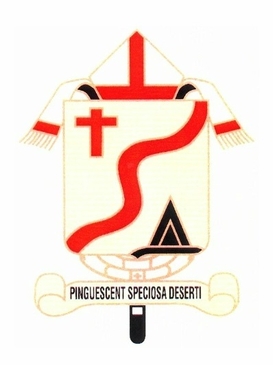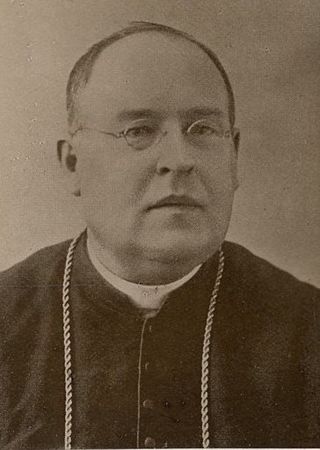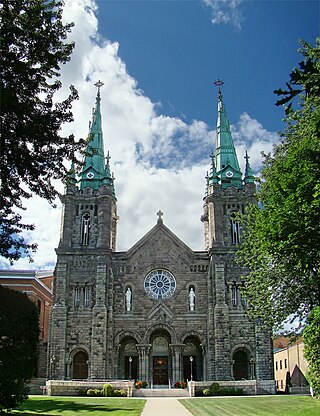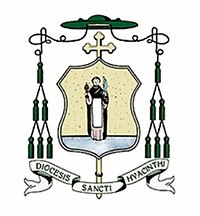
The Archdiocese of Québec is a Catholic archdiocese in Quebec, Canada. Being the first see in the New World north of Mexico, the Archdiocese of Québec is also the primatial see for Canada. The Archdiocese of Québec is also the ecclesiastical provincial for the dioceses of Chicoutimi, Sainte-Anne-de-la-Pocatière and Trois-Rivières. The archdiocese's cathedral is Notre-Dame de Québec in Quebec City.

Ermenek is a town in Karaman Province in the Mediterranean region of Turkey. It is the seat of Ermenek District. Its population is 11,629 (2022). As ancient Germanicopolis, a former bishopric, it remains a Latin Catholic titular see.

The Archdiocese of Grouard–McLennan is a Latin archdiocese of the Catholic Church in Canada and the metropolitan see of an ecclesiastical province for the Roman Catholic Church in northwestern Canada.

The Roman Catholic Archdiocese of Kingston is a Latin Catholic archdiocese that includes part of the federal Province of Ontario in southeastern Canada.

The Archdiocese of Montréal is a Latin Church ecclesiastical territory or archdiocese of the Catholic Church in Canada. A metropolitan see, its archepiscopal see is the Montreal, Quebec. It includes Montreal and surrounding areas within Quebec.

The Roman Catholic Archdiocese of Saint-Boniface is a Latin archdiocese in part of the civil Province of Manitoba in Canada. Despite having no suffragan dioceses, the archdiocese is nominally metropolitan and is an ecclesiastical province by itself. It is currently led by Archbishop Albert LeGatt.

Pierre-Flavien Turgeon was a Canadian Roman Catholic priest and Archbishop of Quebec for 17 years.
The Roman Catholic Diocese of Prince-Albert, in Saskatchewan, is a Latin suffragan in the western Canadian ecclesiastical province of the Metropolitan Archdiocese of Regina.

The Roman Catholic Diocese of Saint-Jean–Longueuil is a suffragan of the Metropolitan Archdiocese of Montréal in Québec, southeastern Canada.

The Roman Catholic Diocese of Saint-Jérôme is a Latin rite suffragan of the Archdiocese of Montréal.

Joseph La Rocque, also spelled Larocque, was a Canadian Roman Catholic priest, professor, and bishop.

Louis-Zéphirin Moreau was a Canadian Roman Catholic prelate who served as the fourth Bishop of Saint-Hyacinthe from 1875 until his death in 1901. He was also the cofounder of the Sisters of St. Joseph of St. Hyacinthe, an congregation he founded with Élisabeth Bergeron, and the founder of the Sisters of Sainte Martha. Moreau was a frail child due to being born premature and so could not help his farmer parents work on their land. He dedicated himself to his studies and later his ecclesial studies despite the fact that illness forced him to slow down his studies which impeded on his progress to ordination. But a benefactor, Jean-Charles Prince, Coadjutor Bishop of Montreal, saw him advance towards his ordination and he served as an aide to several bishops in the diocesan secretariat and later as a diocesan vicar general.

Jean-Charles Prince was a Canadian Roman Catholic priest, teacher, seminary administrator, editor, and Bishop of Saint-Hyacinthe, Lower Canada from 1852 to 1860.

Alexis-Xyste Bernard was Bishop of St. Hyacinthe, Canada.

Maxime Decelles was a Canadian Roman Catholic bishop. He was the 5th Bishop of Saint-Hyacinthe.

The Roman Catholic Archdiocese of Halifax-Yarmouth is a Roman Catholic archdiocese that includes part of the civil province of Nova Scotia.

The Roman Catholic Diocese of Cruzeiro do Sul is a suffragan see in the ecclesiastical province of the Metropolitan Archdiocese of Porto Velho, Acre (state), westernmost Amazonian Brazil.
The Roman Catholic Diocese of La Canea or Cidonia was a bishopric on Crete, with see at present Chania, and afterward was twice a Latin titular see.

The Cathedral of St. Hyacinth the Confessor, located in Saint-Hyacinthe, Quebec, is the cathedral of the Roman Catholic Diocese of Saint-Hyacinthe.


















